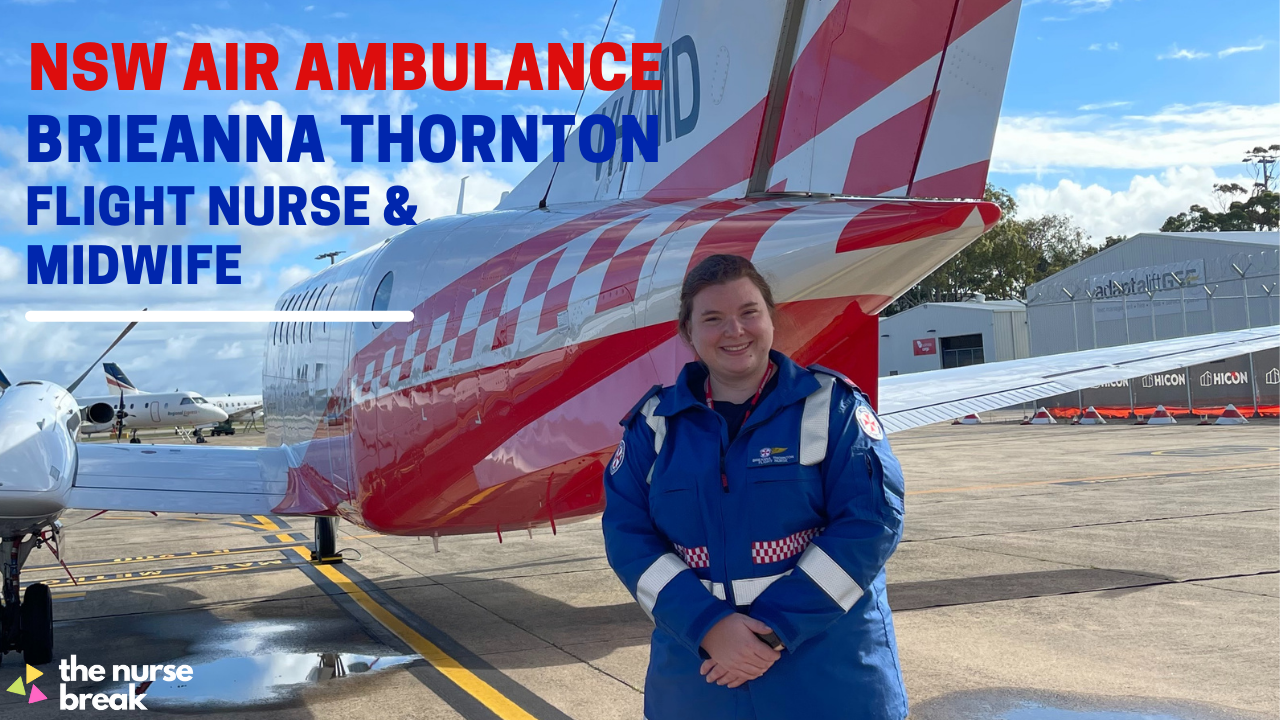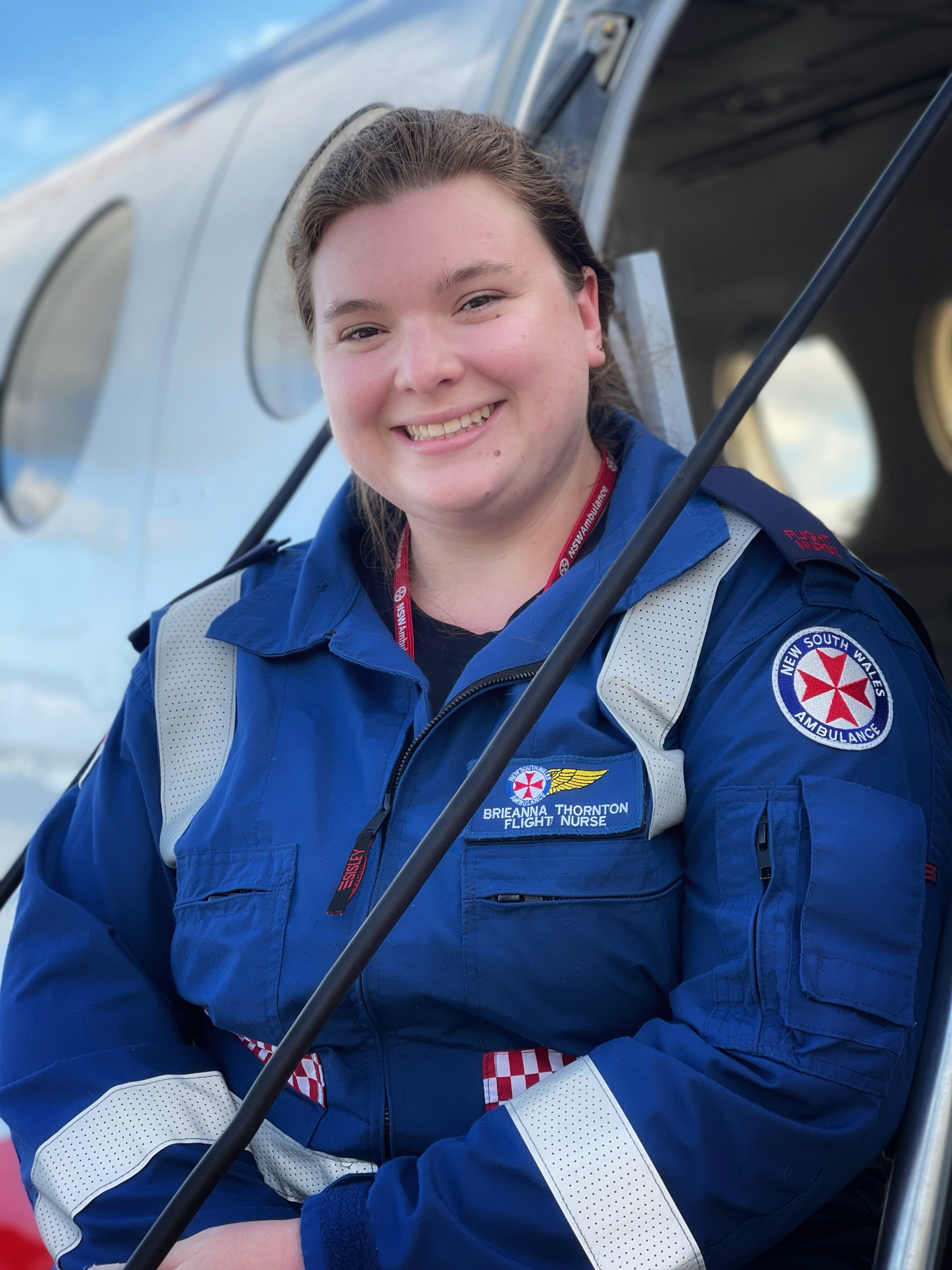Table of Contents
We teamed up with NSW Air Ambulance, to interview some of their Flight Nurse / Midwives about their careers and roles. We are excited to bring you this interview with Brieanna Thornton who has kindly shared her experience as an NSW Air Ambulance Flight Nurse / Midwife. If you’re a nurse with midwifery and critical care experience then the NSW Ambulance Service wants to hear from you – go here.
How did you get into flight nursing with NSW Air Ambulance?
My name is Brieanna. I am a new flight nurse with NSW Air Ambulance, I have been on the job for 7 months now. I have worked as a Registered Nurse in Emergency Departments in Parkes, Bathurst and Wollongong. I attended my Midstart (midwifery) at Campbelltown Hospital.
It has been a goal of mine to be a flight nurse since I was in high school.
What does a typical day look like for you?
A typical day for me really varies as no two days are the same.
Typically, I will come to work and attend a COVID Rapid antigen test. Once I get a negative result, I call the aeromedical control center and sign on. They will advise me of any jobs that I have been tasked too. From there I ring the referring hospital to get an update and handover of the patient I am tasked to transfer. This allows me to plan for any equipment I may need to take with me.
I will then call the pilot I have been rostered with and attend a pre-flight brief. A preflight brief is a discussion that includes weather, fuel stops, planned cabin set up, additional equipment, aeromedical considerations, if the patient will have any family escorting or if the flight nurse needs to go into the hospital.
Once this discussion is complete I will go gather my equipment for the day and head out to the aircraft. I then pack the aircraft and attend the preflight checks. Preflight checks are really important because the aircraft needs to be packed and stocked appropriately for the day as you can’t just go collect the missing equipment later.
I will then load the patients if there are any departing from Sydney otherwise, we will fly to the destination. Once at the destination I will either receive handover on the tarmac from the paramedics or I will go into the hospital to receive the patient depending on their condition and equipment they require.
I will attach monitoring and attend any assessments whilst on the ground as it can be hard to hear over the engines. I will then load the patient onto the aircraft with the pilot. I provide clinical and nursing care, assessment and management during their transfer.
On arriving to the receiving destination, I will either hand over the patient to the paramedics or accompany the patient and escort them into the receiving hospital to handover. Once the mission is complete the pilot and I return to the Sydney base to unpack and restock the aircraft. I then attend all the online documentation once I have returned to base.
Some days will be out to one destination and back and other days have multiple sectors.
A day can change very quickly with diversions and flight plan changes. I have planned to go out and get a patient and end up coming back to Sydney with an entirely different patient than I was initially tasked to go and collect.
Did you do any specific training/what did that entail?
Yes. So upon starting as a flight nurse I spent time in “ground school”. This is essentially spending time in the classroom attending to training and education. I then had a few observer days where I went out flying with another flight nurse and observed what they do during that shift.
I then spent 6 or 7 weeks mentored with various flight nurses and worked closely with them to adjust to the logistics and specific requirements of the job. After 7 weeks of mentored shifts, I had a check flight where a Flight Nurse Educator flew with me and assessed me to make sure I was safe to fly as a single flight nurse. After passing this I have been able to fly as a single flight nurse. I have been studying for my flight nurse exam which is in January.
What kinds of aircraft do you travel on? What unique pieces of equipment do you get to use?
We fly on Beechcraft 350 King Airs.
As a flight nurse I have been trained and get to use a wide variety of equipment. This ranges from special purpose stretchers for bariatric missions, thermocots for neonatal missions, evac mattresses for spinal injuries, EPOC blood gas machines and portable ultrasound for retrievals.
What are the main types of patients you see?
In my current role as a flight nurse I care for patients of all ages. This ranges from neonates to geriatric patients and everything in between including obstetric patients.
My role in their care is the nursing and clinical management whilst they are being transferred by NSW Ambulance on fixed wing aircraft. This can be from rural facilities to metropolitan facilities so patients are able to access specialists and services that may not be available at their local hospital. Sometimes this care can extend onto road transport from airport to hospital. Care can also include returning patients from a metropolitan hospital to a regional or rural facility that’s closer to home when deemed appropriate in their treatment.
What are some of the unique clinical considerations the flight nurses need to make?
Some of the unique clinical considerations for patients include:
At altitude trapped gas expands. This needs to be considered especially when transferring patients who may have trapped gas inside their body such as bowel obstructions, facial and sinus fractures and pneumothorax’s – just to name a few.
At altitude the oxygen molecules are further apart as there is less pressure and this can make it harder for unwell people to maintain normal oxygen saturations leading to hypoxia.
A sea level cabin can be requested for patients whose condition will be affected by altitude.
Some complex patients may require 2 flight nurses. This allows for additional support for any management or treatment that may need to be attended during transfer.
For very unwell or deteriorating patients a flight nurse can upgrade the flight to medevac. This is essentially the equivalent to lights and sirens in the sky, allowing for priority of the aircraft with air traffic control.
What are some misconceptions about flight nursing in your opinions?
In my opinion a common misconception about flight nursing is how isolating it can be at times. Majority of the time we work as single clinicians, meaning If a patient was to deteriorate during the flight, then we need to manage that situation on our own until we are able to land and get additional assistance.
Can you tell us about the most rewarding and difficult aspects of your area of work?
Transferring a patient to a hospital that can offer specialists and services that aren’t available at their local hospital is rewarding. As it may be quiet a long distance for that patient to be transferred by other means such as car or ambulance. However, it can be also very difficult watching the patient saying goodbye to the people who support them such as their families and friends.
Another difficult aspect of the job is the weather. A lot of patients are loaded out on the tarmac in the open and the weather can be pretty varied from heat, rain, wind and cold weather.
What are the skills or experiences required by nurses prior to considering a job in flight nursing?
Skills and experiences required by nurses prior to considering a job in flight nursing include dual registration as a Registered Nurse and Midwife and critical care experience in areas such as emergency or intensive care unit.
Flight nurses get to work very autonomously. An aircraft is a very unique “office” to work from and there is so much variety when it comes to patient care. If you are considering applying as a flight nurse, I highly recommend it! It is an amazing experience, and every day is different.









You must be logged in to post a comment.